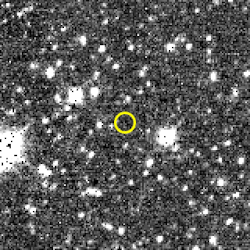Top Qs
Timeline
Chat
Perspective
Lysithea (moon)
Outer moon of Jupiter From Wikipedia, the free encyclopedia
Remove ads
Lysithea /laɪˈsɪθiə/ is a prograde irregular satellite of Jupiter. It was discovered by Seth Barnes Nicholson in 1938 at Mount Wilson Observatory[1] and is named after the mythological Lysithea, daughter of Oceanus and one of Zeus' lovers.[10]
Lysithea did not receive its present name until 1975; before then, it was simply known as Jupiter X. It was sometimes called "Demeter"[11] from 1955 to 1975.
It belongs to the Himalia group, moons orbiting between 11 and 13 Gm from Jupiter at an inclination of about 28.3°.[12] Its orbital elements are as of January 2000. They are continuously changing due to solar and planetary perturbations. It is gray[failed verification] in color (B−V=0.72, V−R=0.36, V−I=0.74) and intermediate between C-type and P-type asteroids.[13][6]

Remove ads
See also
References
External links
Wikiwand - on
Seamless Wikipedia browsing. On steroids.
Remove ads

